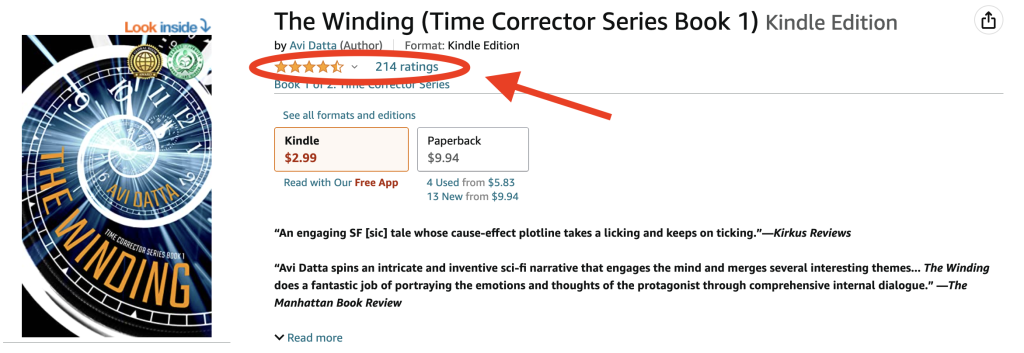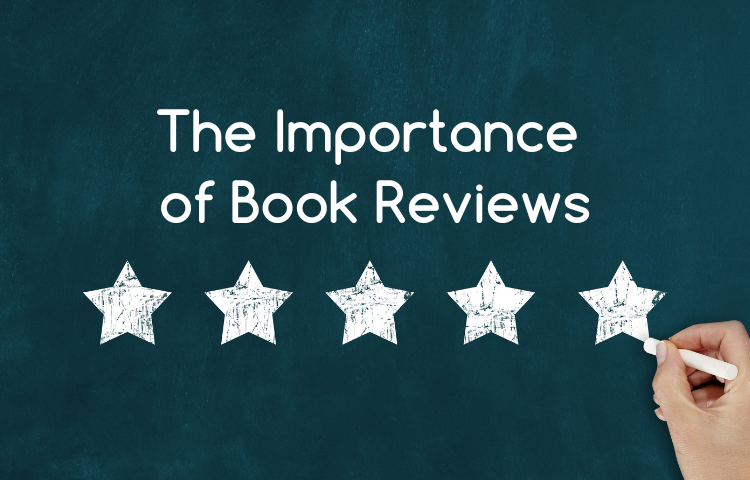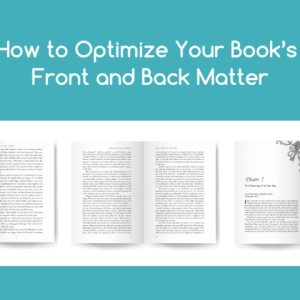Book reviews are an essential part of publishing. They play a crucial role in book marketing and sales, and can make or break a book’s success. As an author, it’s important to understand the difference between reader reviews and editorial reviews for your book as well as the timing and process to secure both types of reviews.
What are reader reviews?
Reader reviews are written by readers who have purchased and read a book or received the book for free. If a reader has purchased the book, retailers like Amazon may mark the review as verified, which can carry extra weight with some book buyers. Readers shopping for books discover these reviews online at book retailers such as Amazon or through online book communities such as Goodreads and BookTok. Reader reviews show up on many sites with an overall rating that is often displayed visually with stars (see image below). Book browsers use these reviews to assess books quickly during the book buying process. Reader reviews can also be a great way for an author to get feedback and build a following.

What are editorial reviews?
Editorial book reviews, also known as book endorsements or blurbs, are written by professional reviewers, industry experts, or influencers. They are often featured on the book’s cover or in its marketing materials. Editorial reviews can help an author establish credibility and authority, especially if the author does not yet have a recognizable brand. These reviews are usually requested by the author, and focus on the book’s merit. Many authors add editorial reviews to the top of their book’s description on retail product pages (see image below) and to the “Editorial Reviews” section of online book and author profiles, such as an Amazon Author page. Additionally, editorial reviews play a big part in supporting successful preorder campaigns, which happen prior to a book’s official launch when reader reviews are not yet visible on a book’s product page.


How to get book reviews
To get book reviews, an author can reach out to professional book reviewers, influencers, and industry experts, or they can leverage their personal and professional networks. Additionally, many authors choose to offer free review copies, also known as Advanced Reader Copies or ARCs, to bloggers, reviewers, or other influencers in exchange for potential reviews. Of course, there is no guarantee whether the review will be positive or negative—or if the recipient of the ARC will actually follow through with a review. This is a risk every author takes when sending out ARCs so it’s important to ask reviewers for permission before sending them. There are also paid editorial sites and journals that guarantee a review—but not necessarily a positive one. At Bublish, we recommend that authors procure a mix of free and paid reviews. Here are some resources we like:
- NetGalley: With over 350,000 active reviewers, NetGalley is the best place to have your book available for reader reviews.
- BookFunnel: A great way to securely send digital ARCs to readers.
- Book bloggers and reviewers
- Kirkus, Booklife by Publisher’s Weekly, and IndieReader for editorial reviews
- Check out how Bublish can help!
Why are book reviews important?
Reader and editorial reviews both play important roles in book marketing and advertising performance by providing “social proof” that a book is worth a reader’s time and money. This, in turn, boosts a book’s visibility and drives sales.
It is important for an author to start requesting reviews at least four to six months before their book’s official launch date. Some authors start securing editorial reviews as soon as the manuscript has been through a copy edit. Other authors wait until the interior layout is ready and send digital ARCs as PDFs as well as some physical copies of the book. At Bublish, we help authors work through a professional book marketing and publishing timeline to make sure they have time to send out ARCs for both reader and editorial reviews. We can even manage the ARC distribution process for authors who distribute their books through Bublish. To learn more about how we can help, click here.
The sooner you secure reviews for your book, the more time you’ll have to use top reviews in your pre-launch promotional efforts. Start early, send out ARCs, and leverage your personal and professional networks to land as many reviews as you can as early as possible. This will create momentum and provide a strong foundation for promoting your work. In the end, careful planning and focused effort around securing editorial and reader reviews is crucial to giving a book the visibility and sales it deserves.




